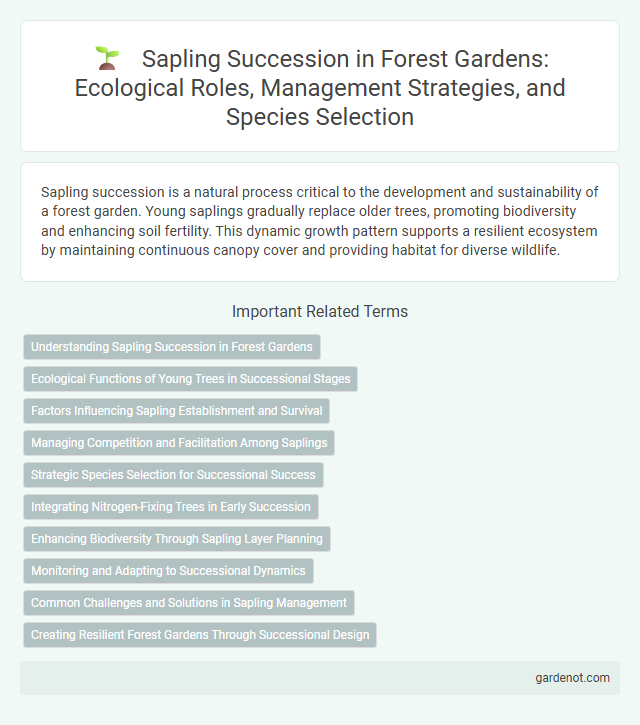Sapling succession is a natural process critical to the development and sustainability of a forest garden. Young saplings gradually replace older trees, promoting biodiversity and enhancing soil fertility. This dynamic growth pattern supports a resilient ecosystem by maintaining continuous canopy cover and providing habitat for diverse wildlife.
Understanding Sapling Succession in Forest Gardens
Sapling succession in forest gardens involves the natural progression of young trees growing beneath mature canopy layers, gradually replacing older vegetation to maintain ecosystem balance. This process enhances biodiversity by supporting diverse plant and animal species while improving soil health through nutrient cycling. Effective management of sapling succession ensures sustainable forest garden productivity and resilience against environmental stressors.
Ecological Functions of Young Trees in Successional Stages
Young saplings in forest garden successional stages play crucial ecological roles by enhancing soil fertility through nitrogen fixation and organic matter accumulation. Their rapid growth stabilizes microclimates, reduces erosion, and creates shade that facilitates the establishment of shade-tolerant understory plants. These saplings also contribute to biodiversity by providing habitat and food sources for various insects, birds, and microorganisms essential for ecological balance.
Factors Influencing Sapling Establishment and Survival
Sapling succession in forest gardens depends heavily on factors such as soil quality, light availability, and moisture levels, which directly influence sapling establishment and survival rates. Microclimatic conditions, including temperature fluctuations and humidity, play a crucial role in determining seedling growth and resilience against pests and diseases. Competition from established vegetation and herbivory pressure from local fauna can significantly affect sapling mortality and forest regeneration dynamics.
Managing Competition and Facilitation Among Saplings
Effective sapling succession in forest gardens relies on carefully managing competition and facilitation among young trees to optimize growth and biodiversity. Techniques such as selective thinning and strategic planting promote resource sharing, enhance light availability, and reduce stress, enabling dominant species to thrive while supporting understory plants. Understanding species-specific interactions allows for tailored interventions that balance competitive exclusion with facilitative relationships, ultimately fostering a resilient and productive forest garden ecosystem.
Strategic Species Selection for Successional Success
Strategic species selection in sapling succession ensures optimal forest garden development by prioritizing pioneer species that improve soil fertility and provide early canopy cover. Nitrogen-fixing plants like alder and black locust accelerate nutrient cycling, facilitating the establishment of shade-tolerant species such as oak and beech. Integrating diverse functional groups enhances ecosystem resilience and promotes continuous successional dynamics.
Integrating Nitrogen-Fixing Trees in Early Succession
Integrating nitrogen-fixing trees such as alder, black locust, or acacia in early succession stages of forest gardens accelerates soil fertility by naturally increasing nitrogen levels. These species establish quickly, support neighboring plants' growth through improved nutrient cycling, and enhance overall ecosystem resilience. Their strategic placement within sapling succession promotes sustainable forest garden development and long-term productivity.
Enhancing Biodiversity Through Sapling Layer Planning
Sapling succession in forest gardens strategically enhances biodiversity by introducing diverse tree species at different growth stages to create a layered canopy structure. This vertical complexity supports various wildlife habitats, improves soil health, and promotes nutrient cycling. Effective sapling layer planning ensures a resilient ecosystem capable of adapting to environmental changes and sustaining long-term ecological balance.
Monitoring and Adapting to Successional Dynamics
Monitoring sapling succession in forest gardens involves regularly assessing growth rates, species composition, and health indicators to track ecological changes over time. Adapting to successional dynamics requires adjusting management practices such as selective pruning, thinning, or introducing new species to maintain biodiversity and optimize canopy structure. Effective succession monitoring enhances resilience, promotes nutrient cycling, and supports long-term productivity in forest garden ecosystems.
Common Challenges and Solutions in Sapling Management
Sapling succession in forest gardens often faces challenges such as competition for light, nutrient scarcity, and pest infestation, which hinder young tree growth and survival. Implementing targeted thinning practices, mulching to conserve soil moisture, and introducing beneficial insects or organic pest controls can effectively mitigate these issues. Regular monitoring of sapling health and adaptive management strategies ensure successful progression toward mature forest structure.
Creating Resilient Forest Gardens Through Successional Design
Sapling succession plays a critical role in creating resilient forest gardens by mimicking natural ecological processes that ensure continuous canopy development and biodiversity. Integrating pioneer and climax species in planned successional stages promotes soil fertility, pest resistance, and microclimate stability, enhancing overall ecosystem health. Strategic planting sequences and species diversity foster adaptability to environmental changes, securing long-term productivity and sustainability.
Sapling succession Infographic

 gardenot.com
gardenot.com